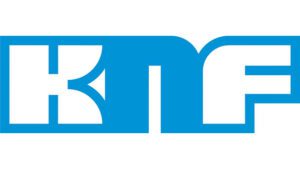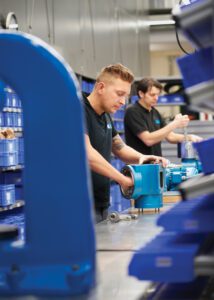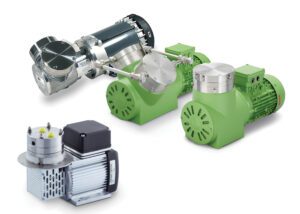Sponsored by 
by Richard Aerts, Process Products Engineer, KNF
Factors to Consider to Ensure Long Service Life with Minimal Maintenance
INTRODUCTION
Designers are usually familiar with the flow and pressure needs of their applications and what they plan on pumping, but that’s just a start. There are many factors specific to each application that need to be evaluated before the correct pump can be selected. Most of these factors can be grouped into environmental, system, and media issues. Consulting early in the design process with a pump company helps ensure that the pump selected will perform as expected while minimizing ongoing maintenance.

PUMP ENVIRONMENT
Most diaphragm pumps operate comfortably in the same conditions we do. The highest probability for a long pump lifetime comes from a clean, temperate, sheltered location. A clean supply of air will provide plenty of cooling by keeping insulating dirt from adhering to the surfaces and fouling internal components. Shelter from the elements will be required if installed outdoors for protection from the elements. Heating or cooling of the enclosure may be required in locations with extreme temperatures. Operation at higher altitude will also affect pump flow performance due to the reduced air pressure.
Often, pumps are required in environments that contain combustible gases. These hazardous location areas require equipment rated to match the explosive potential of what will be present. The Class, Division, Gas Groups, and Temperature Codes must meet or exceed the requirements of the HazLoc area. ATEX pumps may be used in certain situations. Consultation with personnel familiar with NEC/NFPA regulations or the authority with jurisdiction over the area is recommended.
SYSTEM FACTORS
Pressure drops through various system components, such as heat exchangers, getters, etc., must be accounted for when selecting a pump. Just like in a tangled garden hose, the more resistance there is in a pumping application, the more force it takes to push a fluid through it. That is why every flow-path characteristic (tube ID, material, finish, length, filters, orifices, valves, fittings, elbows, mufflers, etc.) should be evaluated for the pressure drop across it. Adding them all up determines the total change in pressure the pump must overcome to generate flow. Restrictions on the pump’s inlet are especially significant because 14.7 psig is the largest possible suction difference at sea level. Pumps should also be sized to produce the required flow rate even when the filters are dirty and need servicing.
Designers should know what the pump’s duty cycle will be. Sometimes there is a question as to whether the pump should run full speed continuously, be cycled on and off, or if a speed control system is required. A list of factors should be weighed to determine the best solution for the application. These factors include motor type (Single phase AC, 3-phase AC, brushless DC, air-driven), noise limits, desired life of the pump, susceptibility to current spikes and vibrations, heat generation, and load at start up and shut down. Controlling the motor’s speed with a BLDC or three phase motor driven by a variable frequency drive is becoming a popular and successful way to address these factors. Running the pump at lower speeds also saves power and extends the preventive maintenance schedule.
THE MEDIA
Media can have a large impact on the system pump choice. Aside from the obvious chemical compatibility issues affecting pump component material selection, other aspects must be examined.
The effect of gas media density must be considered. Light gases such as helium and hydrogen pump at significantly different rates than air through the same system. Most pumps are rated for air flow. Therefore, flow differences due to gas density must be compensated for or the pump will be undersized. The opposite holds true for very dense gases. The pressure drop across the components and line will be greater than with air and will reduce the flow through the system. Liquid media viscosity and flow characteristics must also be considered. Consult the pump manufacturer to determine the correct pump size to compensate for media density/viscosity and flow needs.

Leakage must also be accounted for with lighter gases, especially those that are very costly (e.g. Helium-3) or that are dangerous to release to the atmosphere. Depending on the gas media, leakage of air into the pump (air intrusion) is equally undesirable, either because of contamination/dilution of the media, or because it poses a danger (e.g. pyrophoric gases). The pump manufacture can make pump modifications to mitigate leakage and air intrusion. A leakage monitoring system can also be added.
Media temperatures must also be considered. Some gases, such as helium, are exothermic and heat up when compressed. Depending on the gas and the ultimate system pressure, accommodations to deal with this heat may be required. Water-cooling 316 stainless steel heads, air-cooling aluminum heads, and interhead coolers are possible solutions for handling such media. For other applications – such as hot/wet continuous monitoring systems – the media must remain hot. Not all pumps can handle elevated temperature media, therefore a heat-resistant model may be required. These pumps are usually made of 316 stainless steel and PTFE to handle temperatures up to 460°F (240°C). The heads are extended to keep heat from transferring to the rest of the pump and vented components aid in cooling.
Another common media issue is particulates. Pump technologies have different tolerances for particulate size, hardness, etc. For instance, the gears in gear pumps can be abraded by particulates, potentially shortening their service life to unacceptable levels. Fibers can cause potential issues with certain pump technologies. Ideally, particulates should be removed from media by eliminating their entry and/or development, or be filtered out on the inlet side of the pump. If elimination is impossible or particles are an intrinsic and necessary part of the media, then their characterization is important to proper pump selection.
OTHER FACTORS TO CONSIDER
A trusted pump manufacturing partner will have the application experience necessary to provide guidance through many of the common pitfalls of system design. Some other possible factors to consider include pump orientation and mounting, system sensitivity to pulsation, self-priming needs for liquid pumps, dynamic pump performance control, safeguards against downstream blockages (especially if dangerous media are involved), possible condensation and liquids (for gas systems), regulatory and certification documentation requirements, etc.

In summary, there are many factors that a designer must consider when selecting a pump that will perform successfully over the lifetime of a system. The best solution is determined by assessing the unique application needs and weighing the possible solutions with a trusted pump supplier. A consultative and thorough approach is the path that most often leads to a success.
Richard Aerts is a Process Products Engineer who partners with designers in a variety of industries to understand their system requirements and develop robust pumping solutions. With over 30 years of experience working with electrical, gas powered, and pneumatic systems, he has focused on diaphragm pump technology at KNF Neuberger for the past 14 years. Rich holds a BS in Mechanical Engineering and likes to build and modify guitar effects pedals and amplifiers in his spare time.